As the way to someone’s heart is through their stomach, it is no surprise that cooking and baking with cannabis is growing in popularity. In order to enjoy their pharmacological effects, THC and CBD need to be decarboxylated, or, to put it another way: no heat, no high!
Decarboxylation is an intimidating word and reminds many of us of those awful school chemistry lessons. Nevertheless, anyone interested in cooking and baking with cannabis needs to know what the process is all about.
Let us start at the beginning: Cannabis consists of hundreds of cannabinoids. The best known of these, THC and CBD, are present in the plant in the form of what are known as carboxyl acids. This is why they are referred to as THC-A and CBD-A (‘A’ stands for acid).
When you heat these substances, the acid releases a carbon dioxide molecule in a process known as decarboxylation or activation. This is the natural process of decay, and the application of heat serves to speed it up.
Why do you need to decarb your cannabis? Purely and simply because this is the only way to obtain its pharmacological and psychotropic effects.
Here is how you decarboxylate – properly!
The basic rule is: the higher the temperature, the faster the cannabinoids will be activated. Although not the healthiest way to consume cannabis, lighting up a joint is the quickest way to decarb it.
Furthermore, even when you vape via a vaporizer, a few seconds is all it takes to convert THC-A into THC. Cannabis flower that has been vaporized has already been decarboxylated and can be used to prepare edibles.
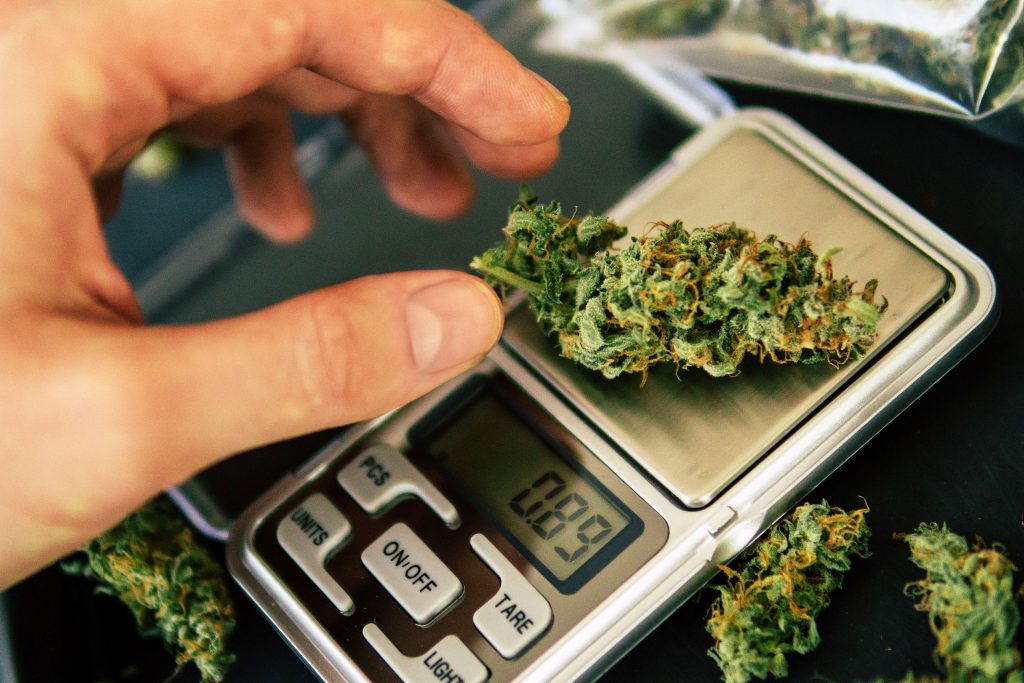
Whether you are eating infused brownies or consuming cannabis concentrates—(“dabbing concentrates”)—the quality of your product will ultimately come down to the temperature you use. Just like you would ruin your cookies by baking the dough longer than necessary, heating cannabis at higher temperatures can also ruin your infused goodies!
Avoid heating your cannabis at higher temperatures (see the chart below). When the decarboxylation process reaches around 70%, THC-A begins to degrade into CBN-A and continues to be converted into CBN. Taking place at a faster rate than the conversion of THCA to THC, it can cause a significant decrease in potency.
If your cannabis is too cold, on the other hand, you may not activate the cannabinoids into their desired compounds.
Each compound present in cannabis has unique chemical properties, and the ideal decarboxylation temperature for one compound may differentiate itself from another. Knowing the boiling point of each terpene and cannabinoid is crucial and will help achieve maximum potency.

Under laboratory conditions, UK patent GW Pharmaceuticals defines the ideal conditions for decarboxylation: it involves heating cannabis at low temperatures for extended periods.
This process ensures that 95% of the cannabinoid acids are converted into their phenol form without creating decomposition products. Another benefit: The aromatic terpenes remain intact. Terpenes are responsible for the aroma and taste, and they also influence the effect of cannabis.
This is often referred to as the “entourage effect” and describes the interactions between cannabinoids and terpenes.
According to the patent, decarboxylation in a closed laboratory should be carried out in two steps:
- First, heat the cannabis briefly to make any remaining moisture evaporate.
- Then heat the plant material twice more for more extended periods.
The best results involve 15 minutes at a temperature of 105°C (221°F) and then 60 to 120 minutes at the same temperature.
If you are using a cannabis variety that has a very high CBD content (defined as >90% CBD as a percentage of the total cannabinoid content), then the second phase needs to be 30 minutes at 140°C (291°F)
The graph below can give you a broader spectrum of the effects of temperature and time on cannabinoid content during decarboxylation.
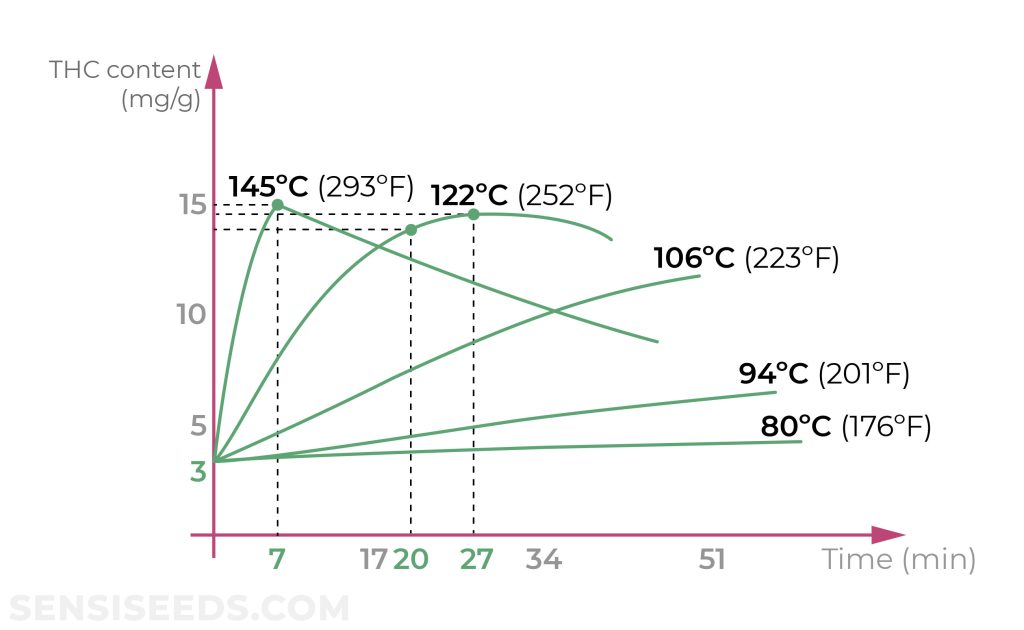
Tea, butter or cookies? It all depends on the final product
Let’s say you want to make some marijuana tea. If you pour boiling water over the buds and leave everything to brew for 5 to 10 minutes, the cannabinoids will not be fully activated. At 100 °C, the plant material needs to be heated for at least 1 hour.
Cannabinoids are fat-soluble so boiling them in water alone is of little value. This is why many traditional cannabis drinks are made with dairy products such as milk or butter, which are heavy in saturated fats. More bioavailability allows the product to retain a more significant proportion of cannabinoids. For vegan alternatives, look for plant milk with high-fat content.

In Northern India, locals celebrate Holi, the festival of colours, with the preparation of Bhang Lassi: an intoxicating drink created from cannabis leaves and flowers. Milk, ghee, and spices are then added to create a refreshing beverage.
A common practice is to heat the material in a closed mason jar, submerged in a pan of water for an hour (“bain-marie”). It evenly transmits heat into the closed container, keeping ingredients warm over a prolonged period.
The result: Cannabis with plenty of flavour and strong effects! Make sure to heat the water slowly, as rapid changes in temperature increase the risk of glass breaking, and do not let it boil dry.

Optimal temperatures for the decarb process!
For best results, crush or grind plant material before activating. Always remember that it is essential to ensure the flower is immaculate before starting the decarb process; otherwise, any dirt, salt residue and nutrients will be retained in the medium.
Washing your cannabis with water directly after harvest can seriously improve the quality of your final product, especially if you have problems with bad air circulation or pesky critters throughout the cultivation cycle. If you are using dried cannabis, simmer it in a large pan of water for an hour or so and then change the water, as, by this point, the water will have changed colour. Repeat this process until the water remains clear.
Many cannabis enthusiasts believe approximately 105 °C (220 °F ) is the perfect temperature for decarboxylation. At that temperature, THCA is converted to THC while preserving many other beneficial cannabinoids and terpenes. Avoid any temperatures above 155 °C (310 ° F) because, at that temperature, the THC starts to deteriorate. High CBD strains tend to decarboxylate slower than those with high THC content, and it is recommended to leave these baking for an extra 25 minutes at 140 °C (290 °F).
How to infuse your medium!
To make cannabis-infused oil or butter, one of our favourite methods is the bain-marie water bath.
If you are using coconut oil as your medium. Once the water reaches a temperature of 185 °C (365 °F), carefully place the sealed mason jar (containing the oil and decarboxylated cannabis) into the bain-marie. Please leave it to infuse for two to four hours at this temperature, stirring occasionally. Top up the water level as necessary.
Remove the mason jar, and strain the enclosed liquid using a fine metal strainer or cheesecloth into a heat-proof container. Leave the remaining infused oil to cool.
If you are using butter as your medium. Please put the desired amount in the mason jar, and submerge it in the bain-marie. Wait until the medium has melted, and mix in the ground cannabis. Close the jar, and leave it to infuse for around two to four hours. Stirring every 20 minutes to ensure that heat is equally conducted.
Again, if you have a fine metal strainer, pour the liquid butter directly through it and into a glass dish or container. Any remaining plant material will be left, and the infused butter can now be cooled. When the butter solidifies, remove it from the container and drain any excess water.
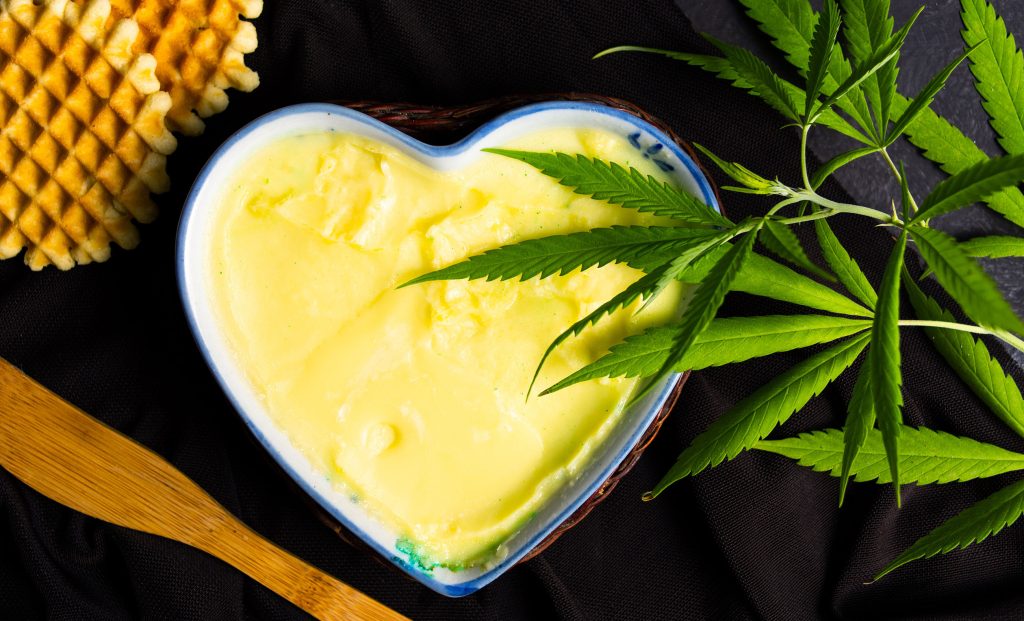
Products should be stored in dark, airtight containers to avoid exposure to light and condensation damage. High temperatures also affect potency, so keeping infused products in a cool, dry and dark place is recommended. Shelf life can be extended with refrigeration, and once frozen, cannabutter can be kept for a very long time.
If you have made some impressive infused goodies or would like to share your thoughts and experiences with decarbing cannabis, let us know in the comments below!
- Disclaimer:Laws and regulations regarding cannabis use differ from country to country. Sensi Seeds therefore strongly advises you to check your local laws and regulations. Do not act in conflict with the law.






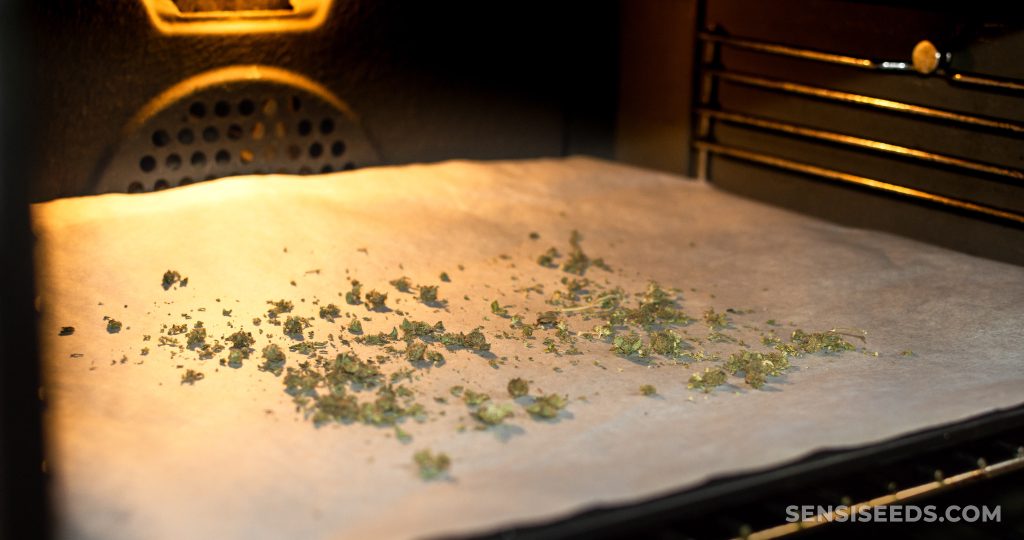
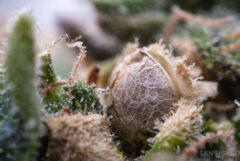


Prolly not the right place for this question, but I have a very painful stenosis that affects my right hip, knee, and shin.
I don’t tolerate ingesting marijuana as gummies, inhaled smoke, or as a consumable. May I use some pure marijuana oil to rub on my places that hurt so badly and get relief that way?
I am just growing my first plants , and I do not want to smoke it , but I am planning on boiling the whole plant , in self sealing cooking bags , do I need to dry it first?
Hi.
I was decarbonaxyating my ground weed at 220deg c not deg f. DOH!
It wasn’t for long a few mins but was smoking well out t oven.
Should I bin it and start again.
It is currently infusing in 95% proof alcohol for 3 wks.
Thoughts!!
Ho there! I’m struggling to find this information. But does this apply also if you are using it directly in a bath for pain? Do you need to decarboxylate it before putting it in the tub? Or would it just be better to make n oil with it to add to. Bath?
Good morning Christa,
Thanks for your comment,
Rather than decarboxylating your cannabis in the bath directly, it would be best to make an infused oil.
Thanks again, and have a great day!
Mark
I’d like to replay to that.. no you do not need to decarb your cannabis…just seeping in a hot bath 107 and up for 20 mins…nice and hot…then when you are able get into bath. Not decarboxlylating your weed still releases the precursor to Thc and cbd called thca and cbda. Both these components are crazy effective for physical and neurological pain, not to mention seizure and anxiety…..oh yea…Hi…from Paula ann…
Also oil does not work in the bath tub…..oil and water dont mix, unless you want them to use an emulsifier. Seep it like tea, its the best most effective for physical pain….at low temps thc starts to oxidize or become active..keep temp low…105-107..bye.
Just use coconut oil or olive oil and just drink it straight up, it’s perfect right before a cup of coffee!! This will work way better and faster for your pain! Trust me I’m on SSDI For my back injury and neck pain from herniated disks and this works great for me! Even helps with Chrones Disease and Acid Reflux as well.It just makes the pain tolerable for a few hours, depending on how much you consume and strength of your Medicine! Hope this helps you 🥴😎🤤😴
Hi,
I’m pretty sure that the cannabis balls and lassis that I had in India were made of green unheated cannabis and they were definitely very psychoactive.
Good morning Ken,
Thanks for your comment,
Yes, I can imagine the bhang lassis and balls were quite potent! I was lucky enough to spend six months in India, and some of the bhang lassis I tried were very strong.
In India, most cannabis is sun-dried, and the natural decarboxylation process gradually changes THC-A into THC. It also must be noted that the experience with cannabis is very subjective both on a physical and mental level. The reaction that we each have to the same strain or dose can be very different. It is our Endocannabinoid System and our own genetics that determine each individual’s specific response to cannabis.
You might also be interested in our article on How to make Bhang Ki Thanda.
Have a great day,
Mark
Hi there, I would like to know if one can do the carboxilation with freshly harvested plant materials, or must it first go through the curing process?
Hey Fanus,
Thanks for your question!
Plant material needs to be dried first before decarboxylation can occur.
I hope you continue to enjoy the blog.
With best wishes,
Mark
You can vape it wet and it tastes really good.
Just takes a bit longer.
NO!!!! DRY AND CURE PROPERLY! DO NOT RUSH THE DRYING DRY AT 60%HUMIDITY FOR AT LEAST 14 DAYS THEN TRIM AND PUT INTO JARS TO CURE FOR AT THE VERY LEAST ONE MONTH , BURPING THE JARS DAILY FOR FIRST 2 WEEK’S THEN EVERY FEW DAYS FOR A FEW MINUTES TILL CURED! YOU’LL THANK ME LATER ,Trust Me I’ve been indulging cannabis for 42 years and it’s the only thing that works that you don’t get addicted to like Oxycodone and Oxycontin and all the pills the doctors can sell you as long as you have insurance, then they cut you off cold turkey or Pay out of pocket and ween yourself off gradually, if you can afford to!!
Hope this help everyone who reads this 🙏 💜
YES!!!!
Hi all this is all top line info you are posting here I’m on legal cbd thc at a cost of $100.00 per week Sativex its pain killing and other medicinal qualities are unsurpassed and staggering life changing after reading your recipes I’m of to the kitchen because in nz law should you have a prescription you can also be in possession of non legal plant/instruments equipment soi can grow and make my own and supplement the prescription lowering my cost but keeping me legal
Hey Tony,
Thank you so much for sharing your experiences.
It is definitely my hope that at the very least, this article can serve as a kind of online gathering point for other medicinal users so that they can compare experiences and possible solutions, and not feel so alone!
Good luck in the kitchen!
With best wishes,
Mark
Hi! I bought some cbd buds online and decided to make my own cbd oil with coconut oil at home. I didn’t have a thermometer to check how hot it got. I did eat two teaspoons of the finished oil which probably means I had way too much and it made me super sleepy and wasn’t a nice high at all. Is it safe to make your own cbd oil at home? Is it true that you can increase the thc levels with heat? I really dont get on with thc too much. I was also reading that maybe the oil got too hot and the thc turned to cbn which is why it made me soo sleepy… but also maybe I just had too much 😛 Would love your advice as really want to be able to make my own cbd oil at home 🙂
Hi Kimbo,
Thanks for your comment and sharing your experiment with us. I can’t really give you advice about homemade CBD oil as I don’t have any experience with it, but I can tell you that increasing the temperature of a vaporiser releases more THC – however, you really have to do it carefully and know what the temperatures are. Maybe one of our readers has had success with making their own CBD oil?
In the meantime, you might find this article, about how we extract the CBD and make our own CBD products, interesting.
Good luck, and as always, take care around hot oil.
With best wishes,
Scarlet
What is the best way to transform your weed into cbn?
How long in the oven and how many degrees?
Thanks
Hi Niels,
I couldn’t find a definite answer to this question (it seems that CBN is a less-wanted cannabinoid) but there is advice that says to avoid converting THC into CBN, you should only have it in the oven for an hour, at temperatures of no more than 120 degrees Celcius. So you could experiment with increasing the time and the temperature.
You might also find this article about CBN interesting, if you haven’t already seen it. Good luck!
With best wishes,
Scarlet
Curious about decarbing directly into hot oil. I have an induction cooktop I use for holding temps at a very precise level for brewing beer. If the decarb process is all about the proper application of heat, it seems logical that a preheated oil bath would decarb perfectly and quite possibly in a shorter period of time due to the low specific heat of oil, which translates to a faster transfer of heat to the plant material and a more precise and constant temperature due to the nature of an oil bath (faster/more consistent than a water bath or heated air in a typical oven). I’ve looked around and most old schoolers can’t answer this question except to say, “It absolutely must be decarbed in an oven first.” Am I missing something? Does anyone have experience trying this?
Hi Dave,
This is an interesting question! My personal experience is of making cannabutter, which involves simmering the cannabis in repeated lots of fresh water before finally adding it to fat and simmering it in the fat for quite some time, all of which serves to decarboxylate it. Then the fat solidifies on top, also removing all the water and other moisture from the fat.
I do wonder if the ‘decarboxylate in an oven’ principle is also to do with removing moisture from the bud before it’s added to oil. Would you end up with a thin layer of water under your oil if you used fresh buds?
I don’t have an induction cooktop but I’m really interested in this topic. Please do let me know how you get on, and if appropriate I’ll update this article.
With best wishes,
Scarlet
Great article and discussions by all. Glad I found this blog site today.
I wonder…
Does anyone know of any benefit, medicinal or psychoactive, to using fresh, raw cannabis sublingually? That is, placing a small amount of fresh, raw bud under the tongue and holding there until fully absorbed and integrated via the saliva into your system? Alternatively, would this be any different than simply eating the herb in raw form (i.e. mastication)? Or are both methods just a waste of time, and herb?
Thank you in advance for all shared insights!
Hi Glenn,
Thanks for your kind words, it’s always lovely to have positive feedback 🙂
The answers to your questions are quite detailed, and can be found in this post about juicing raw cannabis leaves. I hope this gives you enough information, and that you continue to enjoy the blog.
With best wishes,
Scarlet
I simply chew it until tasteless and obtain a quick, strong response from 0.25g
Hello, question,
You say to decarb at low temp 105C to preserve terpenes. But once cannabutter is made, you said to bake with it at 155C or below to avoid THC evap. Wouldn’t all the terpenes and compounds you tried to preserve at 105C and below be lost between 105-155C??
Hi Jennifer,
Thanks for your question. I believe you are correct, some of the terpenes would be lost at higher temperatures, but unfortunately the baking process would not be successful at lower temperatures. So it depends what is more important to the individual, using the butter with a complete-as-possible terpene profile, or having the convenience of cake! I have known people who have solved this problem by making cannabutter and then eating it spread on toast, but it is easy to ingest quite a lot of butter like this, so be careful if you decide to try it.
With best wishes,
Scarlet
Hi can anyone inform me if it’s possible to decarbonise THC power that I have collected in a THC grinder?
Hi Sophie,
I’m guessing that you have used a grinder for herbal cannabis with a screen for the trichome ‘dust’ to fall through and be collected? This powder is probably partly decarboxylated already as the cannabis will have aged whilst drying and curing before you could grind it. You could mix the powder with edible fat like coconut oil and gently heat it following the instructions in this article, and that should work.
If I’ve misunderstood your question, please let me know! In the meantime, I hop you continue to enjoy the blog.
With best wishes,
Scarlet
“Once the water reaches a temperature of 185 °C (365 °F), carefully place the sealed mason jar (containing the oil and decarboxylated cannabis) into the bain-marie.”
Are you sure about those centigrades? Because water boils in 100°C, meaning that in 212°C it would be nothing but steam ready to evaporate completely.
Hello there. I got a green powder from a friend saying hat this is the whole plant crushed to powder . Leaves. Buds .. and everything. And it has mostly cbd that thc in it .. can some one help me here please? I guess i need to activate it with heat right !?
Should i do ot with oven ? As mentuoned in the first 2 methods or should i do it with jar snd waterr heat ?
Thank tou in advance
Hi Saleh,
My advice would be to not try this process with anything that you are not 100% sure is cannabis – ‘green powder’ could be anything! Also, powder is difficult to work with for either the water or oven methods.
With best wishes,
Scarlet
Hi Scarlet,
I add 7g of semi-ground up dried non-decarboxylated cannabis bud to a large mason jar. I then pour approx. 1/4 cup of warmed up organic coconut oil(solid at room temp) over the bud. I like to add enough oil, approx. 1/4 inch above the herb, for proper infusion. I then lightly screw on the mason jar lid & immerse in water up to an inch & a half below the jar’s lidded threads which is well above oil in the jar. The jar is set on an elevated tray within the pot so that it does not make direct contact with the heating surface. I then place a weight on top of the lid to keep the jar in place, bring to a slow boil & simmer(200F) for 4.5 hours, gently agitating the jar every 30 mins & opening the lid a couple of times early on to let co2 escape – though some co2 should escape as I don’t screw the lid on air tight.
It’s important to always maintain the same volume of simmering water throughout the 4.5 hours to ensure adequate decarboxylation & infusion.
After 4.5 hours I strain the oil through a fine metal strainer into another smaller bottle & put the compressed coconut soaked plant material into a bowl & store in the fridge which I’ll later add to my teas. When the bottle of strained oil(absent of plant material) cools down, but before it solidifies, I add approx. 1/2 ml to each gelatin “0” sized capsule & then put them in the fridge immediately so that the coconut oil solidifies within each cap. This is done to minimize the chance of the capsules melting. I’ve made a few batches & stored the capsules at room temp(coconut oil remains solid) up to a month & have never had a leaking/melting issue thus far.
The bowl in the fridge containing the coconut cannabis soaked plant material works super well as an additive to tea. I add a small clump to the hot tea & let stand for 10 seconds, strain the plant material off leaving the coconut oil & tea behind. It taste great & is surprisingly effective.
Thanks again Scarlet 🙂
Hi again Deb!
Thanks so much for this very detailed and easy to follow explanation. I’ve got some trim from the year before last that I keep thinking I should do something with, so I’m going to give your method a try!
Wishing you all the best,
Scarlet
Does it convert the THC in the CBD high % enough to cause a “high”? Like in a CBD flower low% THC pre-roll if this method is followed?
Would dried CBD dominant cannabis, at 15%CBD & 0.5%THC, decarboxylate simply by placing the dried ground bud in a lightly sealed mason jar with coconut oil & immersing the jar, up to the bottle’s neck, in a simmering water bath(200F) for 3-4 hours be sufficient to decarboxylate & infuse?
Thanks muchly – Deb
Hi Deb,
My apologies for it taking so long to respond to your comment, I overlooked it in the recent blog update.
Regarding your question; I’ve never personally tried this method, but it sounds to me like it should work. However, it is very important to ensure the bud is absolutely clean before you start the process, otherwise any dirt and residue of nutrients, pesticides, etc will also be retained in the coconut oil. It’s recommended to put the bud in a pan of water, bring it to the boil and simmer it for at least half an hour, then drain the water off. Repeat this process until the water remains clear. This usually takes about three goes (it’s amazing the amount of gunk that comes off!). As cannabinoids are fat-soluble rather than water-soluble, they won’t be lost during this cleaning process, although try not to bash the cannabis about whilst it’s in the water.
This is the cleaning process usually used for making cannabis fat for cooking; the next step is to add a fresh lot of water to the drained, cleaned cannabis, and then add some kind of edible solid fat (butter and coconut oil are most common) and simmer for an hour. Then turn the heat off and let it cool; the fat will float to the surface and solidify, enabling you to lift it out of the pan. And voila, cannabis-infused coconut oil!
I hope this answers your question.
With best wishes,
Scarlet
Update: So I made a few batches of CBD caps by immersing non-decarboxylated dried ground CBD dominant cannabis & coconut oil in a mason jar semi-sealed into a “bain-marie”(gentle boil/simmering) water bath for 4.5 hours. I’m very happy with the results.
The cannabis may not have been fully decarboxylated which is actually not a negative because CBD-A & THC-A have medicinal properties as well.
Thanks for the cleaning process tip! When cannabis is given or purchased from an unknown source your cleaning tip would be invaluable. Thanks so much Scarlet!
Deb 🙂
Hi Deb,
Thanks so much for the update and for sharing this technique with us. May I ask, did you strain the plant matter out of the coconut oil afterwards?
Regarding the cleaning tip – you’re very welcome! I feel like it’s the sort of thing that should be more widely known 🙂
With best wishes,
Scarlet
Hi there,
After decarbing in the oven, can you store the cannibas for infusion at a later date, or do I need to infuse with oil right away?
Toby
Yes, There are several ways to store your decarboxylated cannabis. A cool, dry and dark place in an airtight container preferably.
So, if I’ve got this correct, GW Pharma was granted a patent for decarboxylation of cannabis by heating – an old and well-known method. If this is true, then anyone who uses heating to decarboxylate is infringing on their patent; any company, any individual. And, I have learned in a different context the unpleasant way, anyone who advises or encourages one to use this method of heating to decarboxylate is violating their assigned rights. The patent offices are staffed with idiots (well, maybe just overworked and underpaid gov’t employees) who often give away patent rights without really doing any research. Then it is on the people who should own the rights to use simple and long-used methods to have to fight in court against corporate lawyers. Just be warned folks – it sure looks like they have patent rights to our basic heat decarbing process! Follow that link in the article and it is right there: “In PCT/GB02/00620 the applicant discloses a method of preparing a herbal drug extract (botanical drug Substance) from medicinal cannabis. The process comprises:
1. a heating step to decarboxylate the acid form of the cannabinoids to their neutral
form; ”
I guess that for many of us we are in the clear since we might use a “recreational cannabis” (and who knows what we do in the privacy of our cellars anyway), but any company using this method for any “medical cannabis” would be in violation of their patent. This is very troublesome.
Please read the actual patent (link was given). The extended times given in the patent application relate to the 40C temperature used in the supercritical fluid extraction process and have nothing to do with the basic decarboxylation!
The decarboxylation is simply the same thing people have been doing all along before this patent – it is nothing magic. They describe a 2-step heating for the decarboxylation. The chopped cannabis is heated to 105C for a while to dry the material; until the water is gone the cannabis can’t rise above 100C and so depending on how wet the cannabis, this would be a variable otherwise. This removal of water will occur if simply heated directly to the typical decarboxylation temperature of 110C to 115C, but driving off the water first allows for a more controlled effect of time at the 110C decarboxylation temperature; a time of 60-90 min (at temperature) is effective at decarboxylation. If you fold the cannabis into an aluminum foil packet with tightly seamed (double folded tightly) edges, it will make much less stink in your house and retain more of the terpenoids (the “stink”) that we would like in the decarbed product. Note that you can just simply eat a small pinch of the dry decarbed bud directly, but please start with a small pinch! Eating dry bud can take an hour to be noticable and last 8 hours or more – start low and go slow. Way less messy and trouble than making oils and tinctures.
Don’t use aluminium foil unless you want toxic heavy metals in your brain, thats very bad advice! Don’t use it in direct contact with food either.
First, the facts. Aluminum is not a heavy metal – chemically speaking – and is not hazardous in an application with mildly heated dry “food” materials. Aluminum has a melting point of over 1220degF and we would be heating it to 230degF in this application. Furthermore, Aluminum spontaneously forms a layer of aluminum oxide that has the higher melting point of 3762degF and is even more inert. There are accounts of substantial aluminum being dissolved from aluminum stockpots that simmer acidic tomato sauce for many hours in restaurants, but the case of heating dry plant material encapsulated by aluminum foil is not at all related. If interested, please read Wikipedia on Aluminum and read the section on Biology and Toxicity, and then you can make an intelligent decision for your own actions. Wikipedia states “There is little evidence that normal exposure to aluminium presents a risk to healthy adult, and there is evidence of no toxicity if it is consumed in amounts not greater than 40 mg/day per kg of body mass.” People should do what they are comfortable with, but use your head and look at evidence. I also don’t believe in a flat earth.
Are vaccines bad too Simon?! Aluminum foil is made from pure Al ingots squished between a couple of massive rollers. I worked at a place that made the stuff. Please stop talking out your ass there Simon. You’re very full of shit and presenting it as fact. Aluminium is not a toxin or a heavy metal. The only thing it comes in contact with is a little bit of food grade lubricant that is on the rollers and that is removed when it’s heated. It is absolutely safe to use to decarb and for food.
Simon Says….Use your brain! Well, Aluminum is not a heavy metal, neither physically not chemically, so you won’t get any heavy metals, sorry. It is atomic number 13, Atomic Weight 26.981… It is NOT a heavy metal. It IS toxic, but you aren’t going to get it by covering food in an oven.
Aluminum has the following properties:
Melting point 933.47 K (660.32 °C, 1220.58 °F)
Boiling point 2743 K (2470 °C, 4478 °F)
The first thing that aluminum does on heating in the presence of air (with oxygen) is form aluminum oxide, a thin layer that has a much higher melting point than aluminum.
Melting point 2,345 K (2,072 °C, 3,762 °F)
Boiling point 3,250 K (2,977 °C, 5,391 °F)
There is no way that aluminum foil will contribute aluminum to a batch of buds being decarboxylated at 120C.
Intelligently used, aluminum foil can even be used for lining a pipe bowl. Really. Again, use your head and don’t put an oxy-acetylene torch on it! With normal gentle heat to vaporize the goodies in the bud, you end up with the aluminum foil covered with tar, not evaporating the aluminum. You get a bowl with a glowing cherry, now that is a different propsition and that is not what I am talking about. You are going to get aluminum into your body from environmental sources like water, foods, food additives and drugs; it will not come from lightly heating your buds at 120C to decarboxylate the cannabinoids.
I would like to point out the tin foil hat you are probably wearing is actually aluminium.
I have found it best to cook with hash and smoke the weed.
Good explanation regarding how long one should heat up the weed to get the THC & CBD. Most in the case of edibles as I guess it requires some practice to bake the perfect weed edibles. Thanks for the share
Hi, I noticed no comments about fats accompanying the tea, is it not a necessity to add it to a cup of tea after decarbing?
Hi Heide,
Just jumping in to say yes, as cannabinoids are fat-soluble is is necessary to include some kind of (edible, obviously) fat if making tea. Simmering buds in fatty milk (oat milk has a high fat content) wil work if you are sure they are clean and free of pesticides or other contaminants, but my recommendation is to make cannabis butter as described in the article and then add that to tea or other drinks. Coconut oil is perfect for this.
You might also be interested in this article on how to make Bhang Ki Thandai.
Thanks for your comment, and I hope you continue to enjoy the blog.
With best wishes,
Scarlet